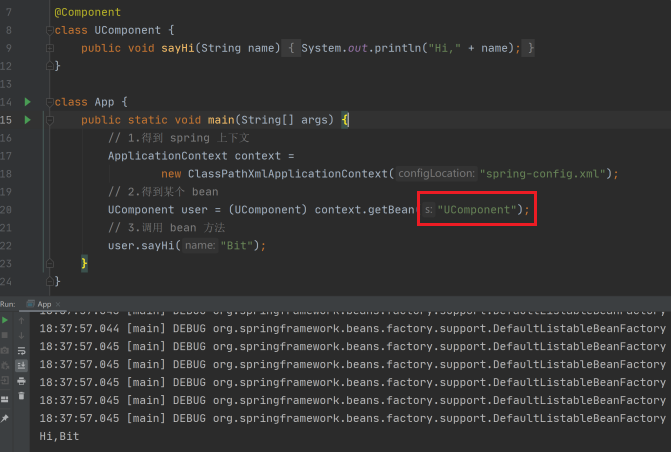@TOC
如何更简单的储存spring
在 Spring 中想要更简单的存储和读取对象的核⼼是使⽤注解,也就是我们接下来要学习 Spring 中的相关注解,来存储和读取 Bean 对象。
以前需要在储存一个bean对象时,需要手动的在配置文件中创建bean,这里直接配置一个扫描路径,将所有需要储存的对象放到该目录下,当我们用在代码中用注解标识该类时,spring会自动的扫描这个路径,将对应的对象自动添加到spring框架中。
1、前置⼯作:配置扫描路径(重要)
在使用注解之前,我们需要配置扫描路径,将所有的对象直接放在该路径下,spring会自动扫描对应的bean并添加到框架中。
创建一个xml配置文件:
<?xml version="1.0" encoding="UTF-8"?> <beans xmlns="http://www.springframework.org/schema/beans" xmlns:xsi="http://www.w3.org/2001/XMLSchema-instance" xmlns:content="http://www.springframework.org/schema/context" xsi:schemaLocation="http://www.springframework.org/schema/beans http://www.springframework.org/schema/beans/spring-beans.xsd http://www.springframework.org/schema/context https://www.springframework.org/schema/context/spring-context.xsd"> <content:component-scan base-package="model"></content:component-scan> </beans>这里的base-package属性中写入对象存放的路径,这里是放在了model包下。

也就是说,即使添加了注解,如果不是在配置的扫描包下的类对象,也是不能被存储到 Spring 中的。
配置完成后,就可以使用注解了。
2、添加注解存储 Bean 对象
想要将对象存储在 Spring 中,有两种注解类型可以实现:
类注解:
- @Controller
- @Service
- @Repository
- @Component
- @Configuration
- @Bean
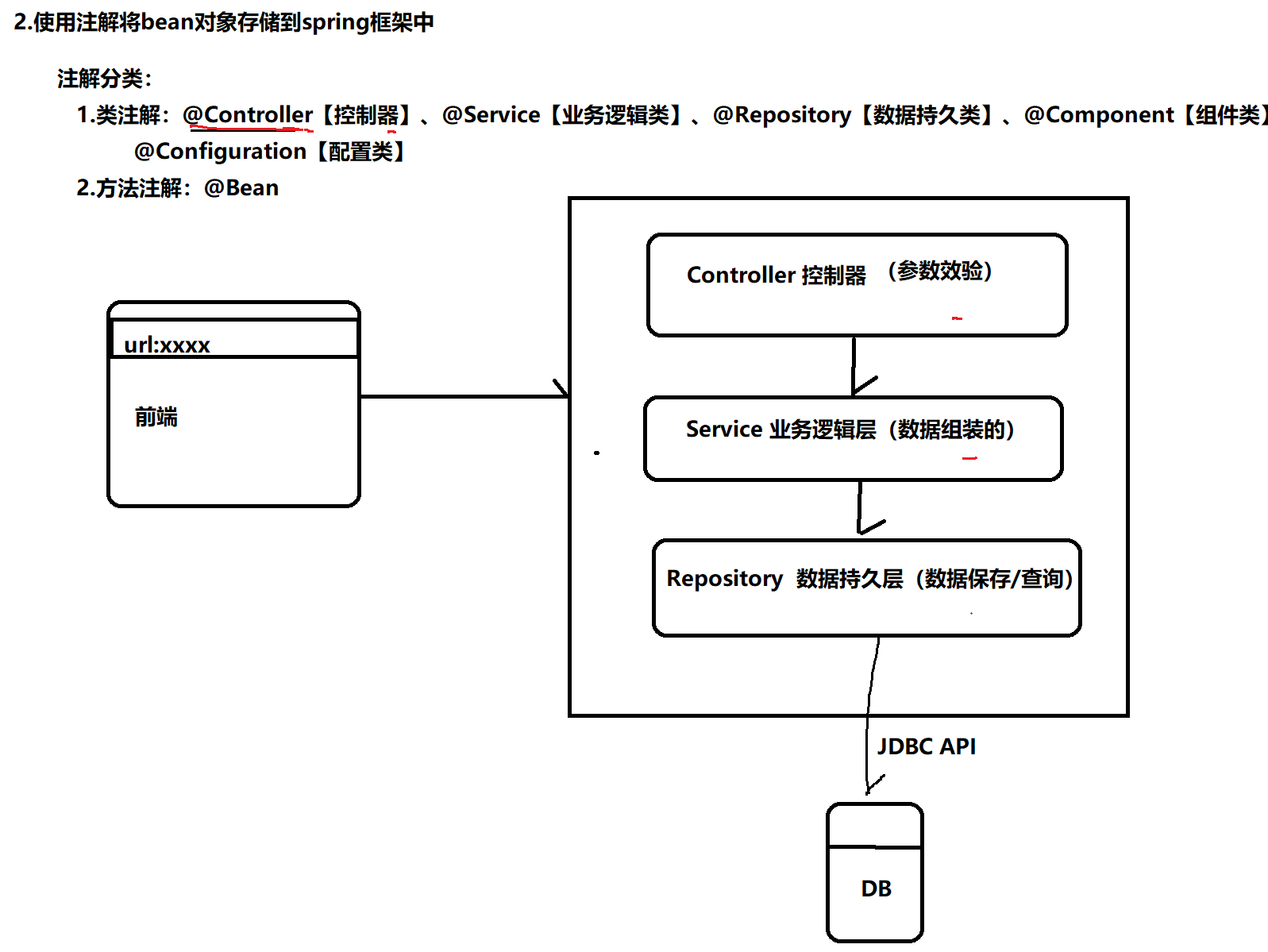
接下来我们分别来看。
1. 类注解:
问:Spring是如何知道需要将哪些Javal类注册到容器中?
使用配置文件或者注解的方式来标识需要处理的Java类
类注解也可以称为组件类注解,即把一些类当做组件进行使用。
类注解之间的关系
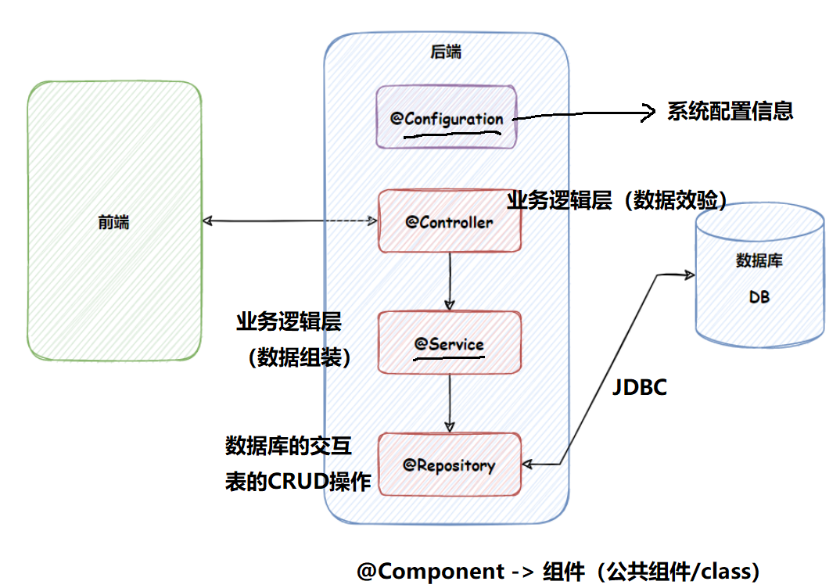
@Component、@Controller、@Service、@Repository这四个注解实际上一类注解,功能相同,用法相同,区别在于标识当前类是什么组件类型,方便程序员快速了解当前类的作用。
@Component可以替代@Controller、@Service、@Repository,因为这三个注解是被@Component标注的,从逻辑上可以理解为是Component的子类。
如下图:Controller、Service、Repository三者都是被Component标注。

① @Controller(控制器存储)
使⽤ @Controller 存储 bean 的代码如下所示:
package model; import org.springframework.stereotype.Controller; @Controller //将当前类储存到Spring,标识此类为控制交互层 public class UserController { public void firstUseController(String name){ System.out.println("Hi,Controller:"+name); } }在测试类中使用:
读取对象的⽅式来读取上⾯的 UserController 对象
import model.HelloApplicationContext; import model.UserController; import org.springframework.context.ApplicationContext; import org.springframework.context.support.ClassPathXmlApplicationContext; public class App { public static void main(String[] args) { ApplicationContext context=new ClassPathXmlApplicationContext("spring.xml"); // UserController userController=(UserController) context.getBean("userController"); userController.firstUseController("Hello!"); } }输出结果:
Hi,Controller:Hello!注意事项:

② @Service(服务存储)
使⽤ @Service 存储 bean 的代码如下所示:
package model; import org.springframework.stereotype.Service; @Service //将此类储存到String中,这个类中可以进行数据组装 public class UserService { public void firstUseService(String name){ System.out.println("Hi,Service:"+name); } }在测试类中读取 bean :
import model.HelloApplicationContext; import model.UserController; import model.UserService; import org.springframework.context.ApplicationContext; import org.springframework.context.support.ClassPathXmlApplicationContext; public class App { public static void main(String[] args) { ApplicationContext context=new ClassPathXmlApplicationContext("spring.xml"); UserService userService=(UserService) context.getBean("userService"); userService.firstUseService("Hello!"); } }输出:
Hi,Service:Hello!③ @Repository
package model; import org.springframework.stereotype.Repository; @Repository//将此类储存到String中,标识此类是数据访问组件 public class UserRepository { public void firstUseRepository(String name){ System.out.println("Hi,Repository:"+name); } }在测试类中使用:
import model.HelloApplicationContext; import model.UserController; import model.UserRepository; import model.UserService; import org.springframework.context.ApplicationContext; import org.springframework.context.support.ClassPathXmlApplicationContext; public class App { public static void main(String[] args) { ApplicationContext context=new ClassPathXmlApplicationContext("spring.xml"); UserRepository userRepository=(UserRepository) context.getBean("userRepository"); userRepository.firstUseRepository("Hello!"); } }输出:
Hi,Repository:Hello!④ @Component
package model; import org.springframework.stereotype.Component; @Component public class UserComponent { public void firstUseComponent(String name){ System.out.println("Hi,Component:"+name); } }在测试类中使用:
import model.*; import org.springframework.context.ApplicationContext; import org.springframework.context.support.ClassPathXmlApplicationContext; public class App { public static void main(String[] args) { ApplicationContext context=new ClassPathXmlApplicationContext("spring.xml"); UserComponent userComponent=(UserComponent) context.getBean("userComponent"); userComponent.firstUseComponent("Hello!"); } }输出:
Hi,Component:Hello!注意点:
- 被注解的Java类会被当做Bean对象储存到spring中,这个对象的默认名称是类名的首字母小写,其余部分不变。

- @Service也可以自定义Bean名称,但是必须唯一。
- 尽量使用对应的组件注解来替换@Component,因为未来的Spring版本中,@Controller,@Service,@Repository可能会携带更多语义。
2. 方法注解
@Bean
方法注解:
@Bean注解在方法前,作用是让这个方法产生一个Bean对象,然后这个Bean对象交给容器进行管理。这个方法只会spring只会调用一次,然后将这个对象放入自己的IOC容器中。
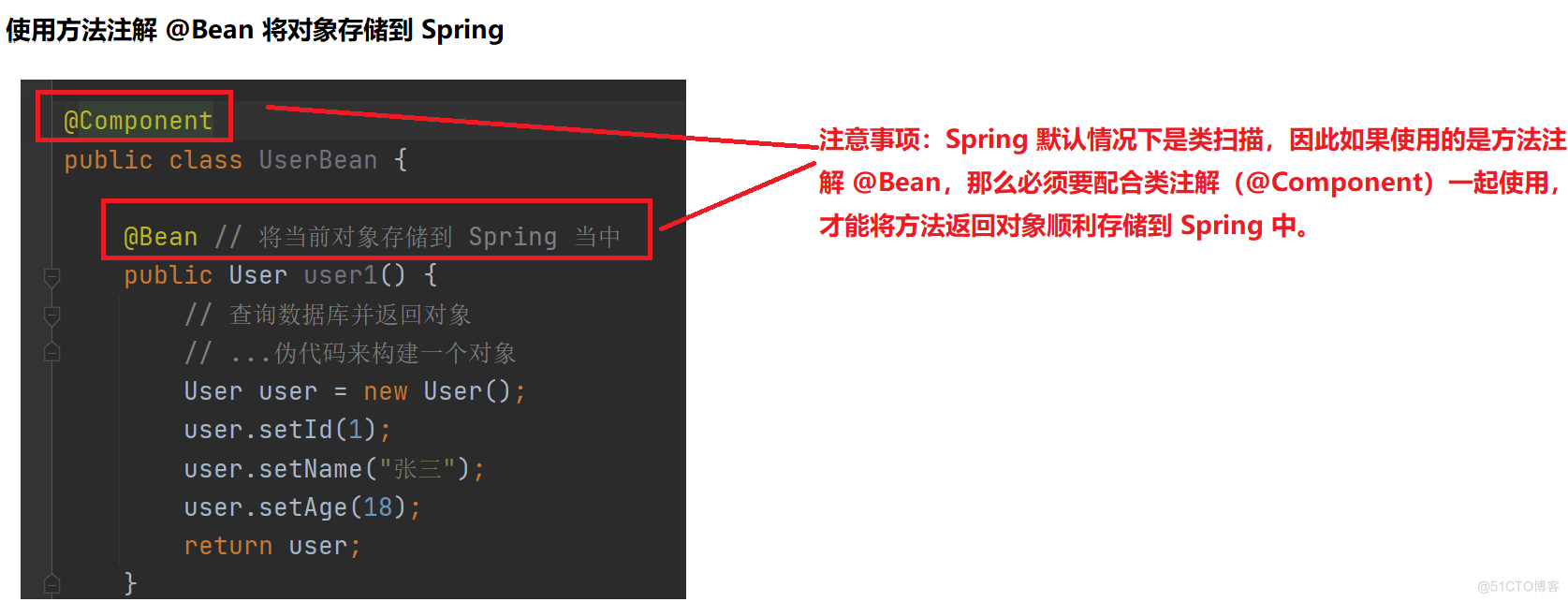
在测试类中运行:
import model.*; import org.springframework.context.ApplicationContext; import org.springframework.context.support.ClassPathXmlApplicationContext; import javax.jws.soap.SOAPBinding; public class App { public static void main(String[] args) { //1.获取上下文对象 ApplicationContext context=new ClassPathXmlApplicationContext("spring.xml"); //2.获取spring中存入的bean对象,id默认是类名首字母小写,其余不变 UserBean user=(UserBean)context.getBean("users"); //3.调用方法 System.out.println(user.toString()); } }运行结果如下:
UserBean{name='张三', Id=1, age=18}注意:
Spring在默认情况下是类扫描,如果使用方法注解@Bean,需要搭配类注解@Component或者@Configuration一起使用,否则spring无法扫描到这个方法,就不能将方法返回对象储存到spring中。
@Bean 重命名
在使用@Bean时,我们可以对方法进行重命名,可以同时为该方法创建多个名字:
这个重命名的 name 其实是⼀个数组,⼀个 bean 可以有多个名字

当创建了多个名字后,原来的方法名就失效,我们可以使用重命名来获取bean对象。

为什么要有这么多 类注解?
这和为什么每个省/市都有⾃⼰的⻋牌号是⼀样的?
⽐如陕⻄的⻋牌号就是:陕X:XXXXXX,北京的⻋牌号:京X:XXXXXX,⼀样。甚⾄⼀个省不同的县区也是不同的,⽐如⻄安就是,陕A:XXXXX,咸阳:陕B:XXXXXX,宝鸡,陕C:XXXXXX,⼀样。这样做的好处除了可以节约号码之外,更重要的作⽤是可以直观的标识⼀辆⻋的归属地。
那么为什么需要怎么多的类注解也是相同的原因,就是让程序员看到类注解之后,就能直接了解当前类 的⽤途,⽐如:
-
@Controller:表示的是业务逻辑层;
-
@Servie:服务层;
-
@Repository:持久层;
- @Configuration:配置层
程序的⼯程分层,调⽤流程如下:
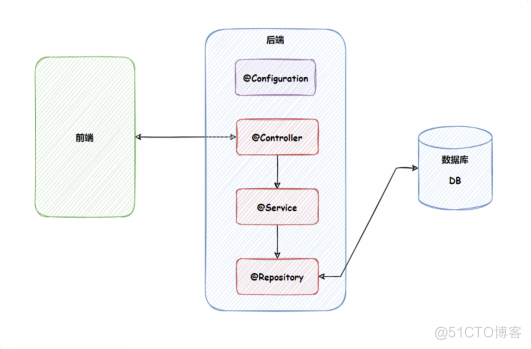
类注解之间的关系?
查看 @Controller / @Service / @Repository / @Configuration 等注解的源码发现:
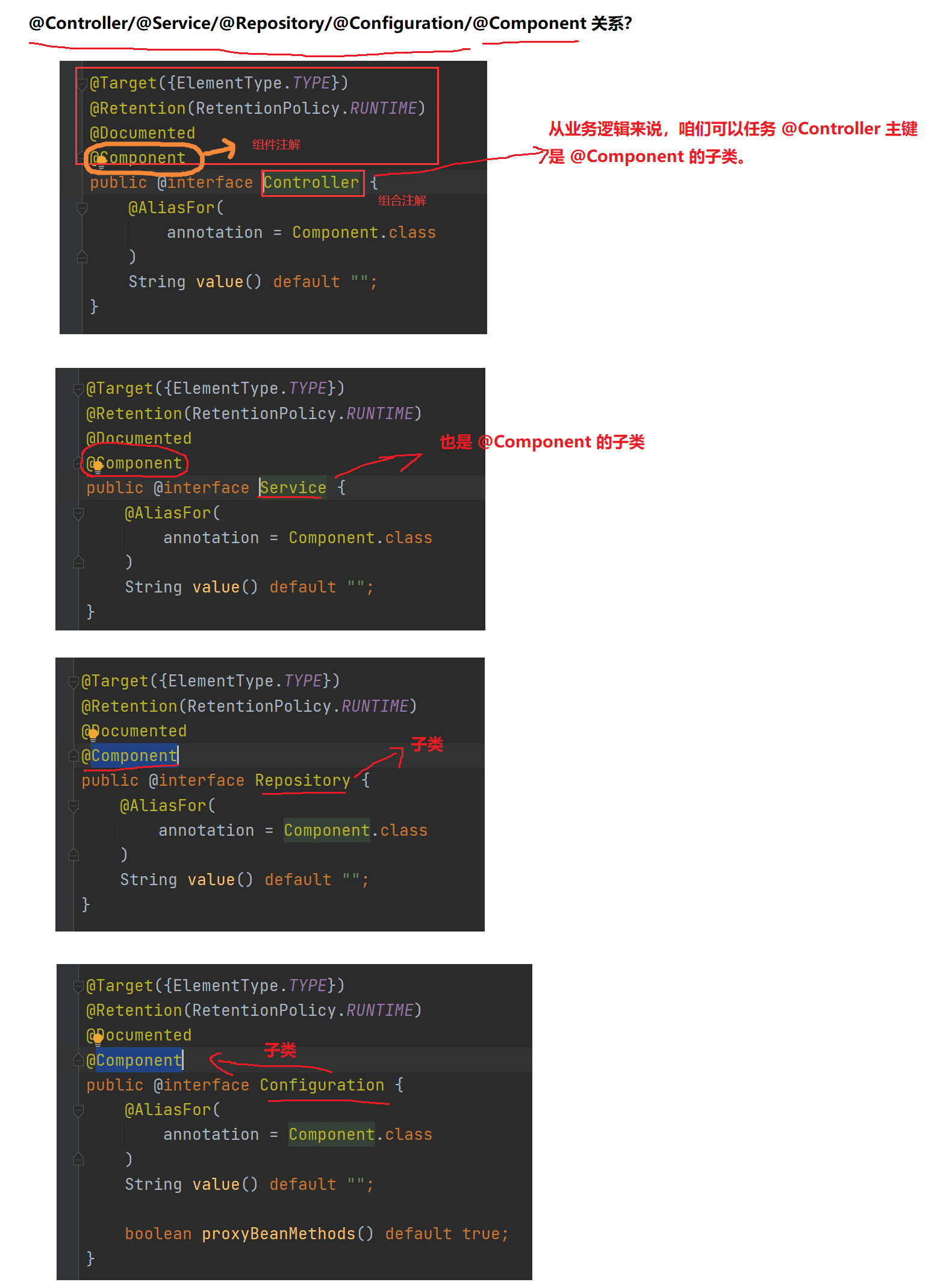
其实这些注解⾥⾯都有⼀个注解 @Component,说明它们本身就是属于 @Component 的“⼦类”。
Spring 如何制作出类注解的 beanName?
通过上⾯示例,我们可以看出:
通常我们 bean 使⽤的都是标准的⼤驼峰命名,
⽽读取的时候⾸字⺟⼩写就可以获取到 bean 了,如下图所示:
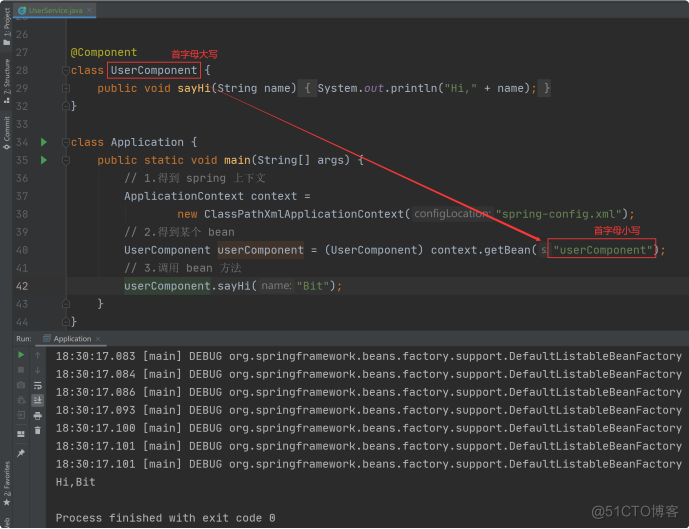
然⽽,当我们⾸字⺟和第⼆个字⺟都是⼤写时,就不能正常读取到 bean 了,如下图所示:
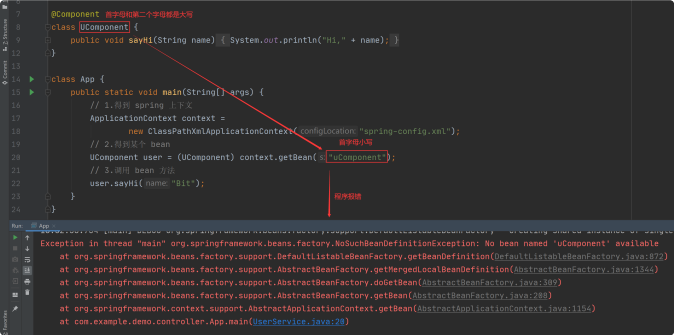
如果使用原名就又可以读取了,这是为什么呢?
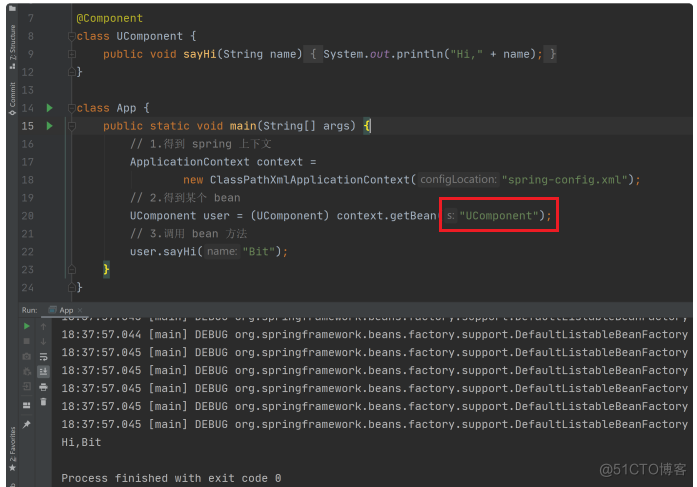
这个时候,我们就要查询 Spring 关于 bean 存储时⽣成的命名规则了。
我们可以在 Idea 中使⽤搜索关键字 beanName 可以看到以下内容:
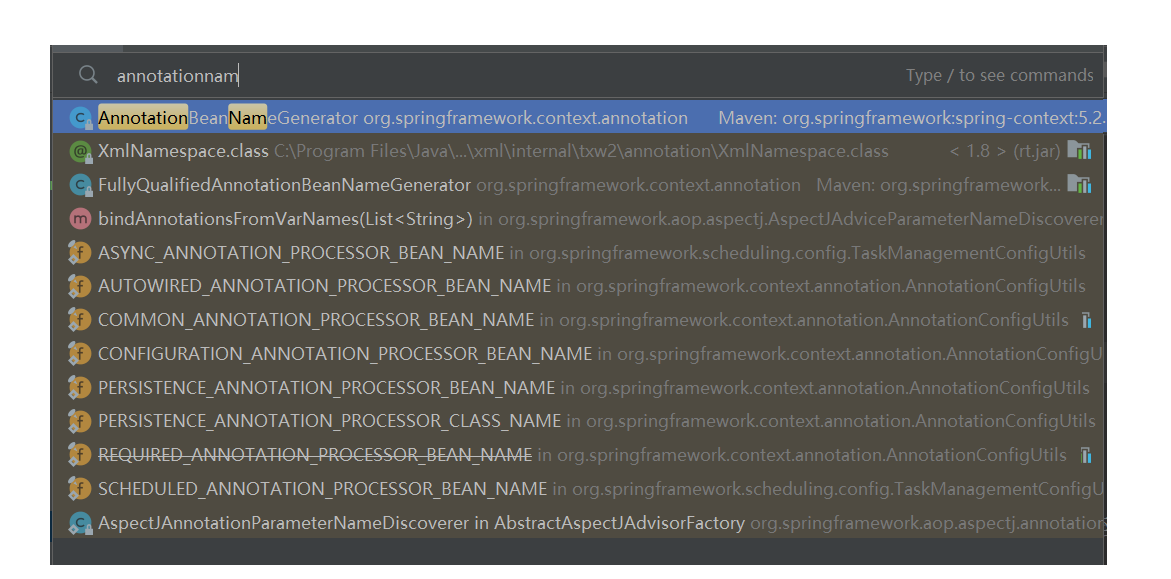
顺藤摸⽠,我们最后找到了 bean 对象的命名规则的⽅法
它使⽤的是 JDK Introspector 中的 decapitalize ⽅法,源码如下:
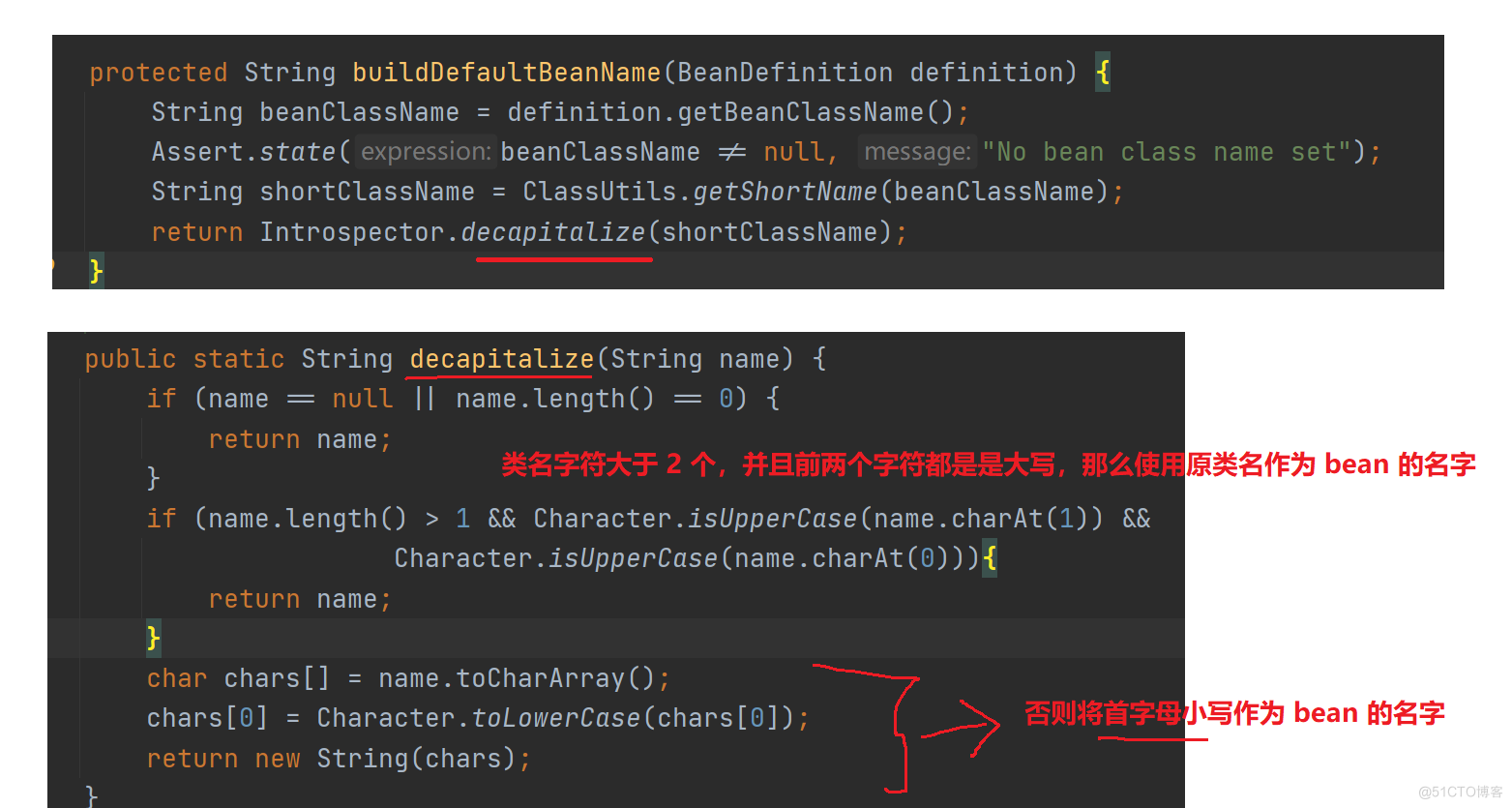
所以对于上⾯报错的代码,我们只要改为以下代码就可以正常运⾏了:
